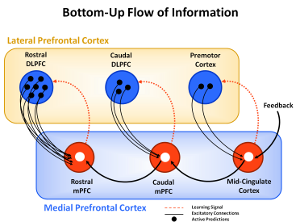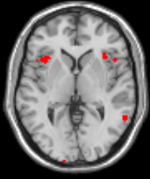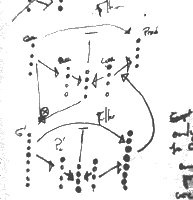Alexander Lab @ FAU
Anterior Cingulate Cortex: Expectation and Deviation

Activity in anterior cingulate cortex (ACC) is routinely observed across an array of tasks and methodologies. The diversity of contexts in which cingulate activity has been observed has led to a similar profusion of interpretations regarding the function of ACC. Roles attributed to the region include signaling error, processing behavioral conflict, learning the value of actions, indicating painful stimuli, predicting reward, and several others. Remarkably, the wide range of effects observed in ACC can be interpreted as a manifestation of two core functions: ACC learns expectations of future events based on the present state of the environment, and signals deviations between expected actual events. These two roles of cingulate, expectation and deviation, constitute a general computational mechanism that is applied over a broad range of contexts.
Dorsolateral Prefrontal Cortex: Representing Error to Improve Predictions

Dorsolateral prefrontal cortex (dlPFC) is frequently coactivated with ACC, especially in situations involving complex relationships amongst elements of the environment. Generally, dlPFC is thought to represent information needed to perform specific tasks over extended periods of time ("working memory"), and is hypothesized to be organized along a rostrocaudal abstraction gradient. In this framework, caudal aspects of dlPFC represent concrete, temporally proximal relationships, while rostral aspects represent abstract relationships such as rules or task-sets. Our current work investigates the nature of representations in dlPFC, and suggests that a wide range of empirical observations of dlPFC from behavioral, EEG, fMRI, single-unit neurophysiology, and lesion studies can be explained by a model in which dlPFC learns to represent error signals generated by ACC, and that the purpose for representing error signals is to modulate future predictions in order to improve performance.
Future Directions: State vs. Outcome Uncertainty

Like dlPFC, activity in anterior insular cortex (AIc) is frequently observed in conjunction with ACC, particularly following behavioral errors. A critical question is whether and how error signals generated by AIc differ from those generated by ACC. One possibility is that, while ACC signals discrepancies between the expected and observed outcomes of actions, AIc signals deviations between inferred and observed states of the environment. Preliminary results suggest that error-related activity in AIc is primarily related to situations in which an inferred context is revealed to be invalid, independent of the consequences implied regarding the eventual outcome. Future work will explore this dissociation, and integrate state-based uncertainty with the PRO model in order to derive predictions for future study.
Future Directions: Goal-Oriented Decision Making

Our previous work suggests that a framework using a common neural currency of prediction and prediction error can describe the function and interaction of regions in prefrontal cortex. Computational models built on this framework comprehensively account for effects observed in selected regions of PFC, and learn to perform experimental tasks in a manner comparable to humans. These tasks represent one operating mode of the brain: integrating information observed in the past in order to determine the best response in the present. Future work will investigate whether the prediction/prediction error framework can similarly be applied to situations in which present behaviors are informed by prospective events: goal-oriented decision making and planning. We expect that additional regions of prefrontal cortex, including orbitofrontal cortex and frontal pole, are likely to play critical roles in this form of cognition.
Future Directions: Generalization and Specification

Accomplishing a task requires both the ability to capitalize on previous experience in order to efficiently determine appropriate behaviors, as well as the ability to tailor a response to the particular conditions of the task: generalization and specification, respectively. The prediction/prediction error framework suggests a means by which task stimuli might be dynamically mapped to previously learned error representations, and how information specific to a particular context may be used to modify active representations of error. We hypothesize that anterior insula and ventrolateral prefrontal cortex play a critical role determining when and how stimuli are mapped to appropriate internal representations.